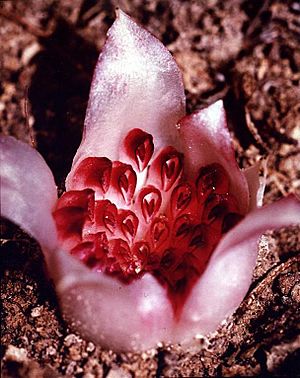Underground orchids facts for kids
Quick facts for kids Underground orchids |
|
|---|---|
 |
|
| Rhizanthella gardneri | |
| Scientific classification |
|
| Kingdom: | Plantae |
| Clade: | Tracheophytes |
| Clade: | Angiosperms |
| Clade: | Monocots |
| Order: | Asparagales |
| Family: | Orchidaceae |
| Subfamily: | Orchidoideae |
| Tribe: | Diurideae |
| Subtribe: | Rhizanthellinae R.S.Rogers |
| Genus: | Rhizanthella R.S.Rogers |
| Type species | |
| Rhizanthella gardneri R.S.Rogers (1928)
|
|
| Synonyms | |
|
Cryptanthemis Rupp |
|
Rhizanthella, also known as underground orchids, is a group of special flowering plants. They belong to the orchid family, called Orchidaceae. These unique plants are found only in Australia. All underground orchids live completely hidden beneath the ground. They do not have leaves and get their food through a special partnership with tiny fungi. This partnership is called symbiosis. Their flowers grow in a cluster, often just at ground level. However, they are usually covered by soil or fallen leaves. Scientists still don't know much about how these hidden flowers are pollinated.
Contents
What Makes Underground Orchids Special?
Orchids in the Rhizanthella group mostly live underground. They are perennial plants, meaning they live for more than two years. They have thick, fleshy stems that grow underground. New shoots grow from these stems. These shoots have small, colorless, leaf-like parts called cataphylls.
Underground orchids do not have roots. Instead, new tubers (like small potato-like growths) form at the ends of short stems. Their leaves are very tiny and look like scales. They don't have the green color of chlorophyll, which plants usually use to make food. These scale-like leaves press against the stems.
How Their Flowers Look
The flowers of Rhizanthella grow in a cluster, forming a "head." This head contains many flowers. It usually sits at or just above the ground. But, it's almost always hidden by leaf litter or soil. A large number of overlapping leaf-like structures called bracts surround the flower head. Each tiny flower also has a long, upright bract at its base.
The flowers are dull in color and don't have a stalk. They are arranged in a spiral shape. The sepals (outer flower parts) and petals (inner flower parts) form a short, curved hood. This hood covers the labellum (a special petal) and the column (the part that holds the pollen). The hood is open on one side.
The side sepals are joined together and also to the top sepal at their bases. The petals are shorter than the sepals. They are joined at their bases to the column. The labellum is different from the other petals and sepals. It is thick, fleshy, and does not produce nectar. The column is short and has small wings.
Life Cycle and Seeds
The time when these orchids flower depends on the specific type. After flowering, they produce a fruit. This fruit is a berry that does not split open when ripe. Each berry contains about 50 to 100 tiny seeds.
Underground orchids do not have chloroplasts, which are the parts of plants that contain chlorophyll and make food using sunlight. However, they still have genes related to these parts. For example, Rhizanthella gardneri has the smallest set of genes for these cell parts ever found in land plants.
Naming and Discovery
The first underground orchid was officially described by Richard Sanders Rogers in 1928. He named it Rhizanthella gardneri. He published his description in a science journal called the Journal of the Royal Society of Western Australia.
The name "Rhizanthella" comes from an older plant name, Rhizanthes. Rhizanthes is a plant that gets its food from other plants. The name "Rhizanthes" comes from two Ancient Greek words: rhiza, meaning "root," and anthos, meaning "flower." So, Rhizanthella means "little root-flower."
Types of Underground Orchids
Currently, four types of Rhizanthella are officially recognized. A fifth type has been described, but not all experts agree on it yet. Here are the recognized species:
- Rhizanthella gardneri – This is the western underground orchid, found in Western Australia.
- Rhizanthella johnstonii – This is the south coast underground orchid, also from Western Australia.
- Rhizanthella omissa – Found in Queensland.
- Rhizanthella slateri – This is the eastern Australian underground orchid, found in New South Wales.
In 2020, a fifth species, Rhizanthella speciosa, was found in New South Wales. It was described by scientists Mark Clements and David Jones. However, as of September 2020, this name has not been fully accepted by all plant experts.
Where They Live
Rhizanthella gardneri grows in the southwest part of Western Australia. It often grows near a type of plant called broombush (Melaleuca uncinata). Rhizanthella johnstonii, also from Western Australia, was once thought to be the same as R. gardneri but was identified as a separate species in 2018.
Rhizanthella omissa has only been found once. It was discovered at a high elevation in the Lamington National Park in Queensland. Rhizanthella slateri (which used to be called Cryptanthemis slateri) lives in the Blue Mountains and similar areas in New South Wales. It grows in sclerophyll forests, which have tough-leaved plants.
The newest discovered species, Rhizanthella speciosa, was found in 2016. It lives in wet sclerophyll forests in Barrington Tops. This is different from the drier, more open forests where R. slateri grows.
How They Are Pollinated
Scientists still don't fully understand how Rhizanthella orchids are pollinated. It's a big mystery because they live underground! Only a few observations have been made. These include a small fly from the genus Megaselia, some small wasps, and termites. These insects were seen carrying the pollen of Rhizanthella. This suggests they might play a role in helping these hidden flowers reproduce.
See also
 In Spanish: Rhizanthella para niños
In Spanish: Rhizanthella para niños

